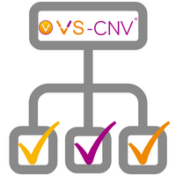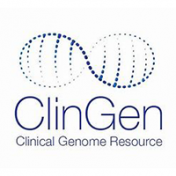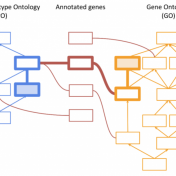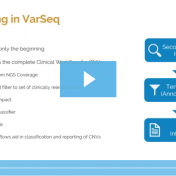About Nathan Fortier
Nathan Fortier, Ph.D, Director of Research for Golden Helix, joined the development team in June of 2014. Nathan obtained his Bachelor’s degree in Software Engineering from Montana Tech University in May 2011, received a Master’s degree in Computer Science from Montana State University in May 2014, and received his Ph.D. in Computer Science from Montana State University in May 2015. Nathan works on data curation, script development, and product code. When not working, Nathan enjoys hiking and playing music.
In this blog post, we will explore the nuances of variant calling and import in the context of VSPGx. We will discuss the importance of integrating must-call variant definitions into the calling processes and provide guidance on incorporating copy number variants (CNVs) and structural variations (SVs) into your PGx analysis workflow. Must Call Variant Files To ensure the optimal performance… Read more »
In our recent webcast, we unveiled the integration of the Twist Bioscience Exome 2.0 Plus Comprehensive Exome Spike-in capture panel with VS-CNV, marking a significant advancement in genetic diagnostics. By addressing the limitations of standard exome kits that miss vast genomic regions, our enhanced panel introduces ‘backbone’ probes for comprehensive genomic coverage. This innovation enables the detection of CNVs, LOH,… Read more »
We are excited to announce the release of our gnomAD v4 annotation tracks for VarSeq. This version of the GnomAD database represents a significant leap forward, including data from an impressive cohort of over 800,000 individuals — a remarkable 5x expansion compared to the previous releases. Notably, this dataset is comprised of two distinct callsets: exome sequencing data from 730,947… Read more »
Last month, the researchers at Google DeepMind announced the release of AlphaMissense, a new missense prediction algorithm that leverages the protein structure prediction model AlphaFold to distinguish between benign and pathogenic missense variants (Cheng et al., 2023). AlphaFold is a model for the prediction of protein structures from amino acid sequences. During the development of AlphaMissense, the AlphaFold model was… Read more »
Traditionally genetic tests in cancer have focused on small gene panels that restrict their analysis to a small number of well-studied cancer genes. However, as sequencing costs have decreased, many clinical laboratories have embraced comprehensive genomic profiling tests that rely on whole exome and whole genome next-generation sequencing (NGS) workflows, which can detect millions of high-quality variants for a single… Read more »
While the analysis of gene fusions is crucial for understanding the genetic basis of cancer, the process of interpreting these mutations can be challenging. One important component of fusion interpretation is the identification of relevant publications. To aid researchers in the search for publications related to specific gene fusions, Felix Mitelman, and colleagues have created the Mitelman Database of Chromosome… Read more »
The AMP guidelines workflow in VSClinical provides a user-friendly tool for the interpretation of somatic biomarkers across the entire spectrum of genomic variation. One of the most useful features of this workflow is its ability to streamline the evaluation of clinical evidence for a somatic biomarker using the AMP Tier evidence levels. The AMP Guidelines classify a biomarker into one… Read more »
Unlock the potential of VarSeq for efficient analysis of structural variants, providing robust annotation, filtering, and interpretation of intricate genetic variations. While the analysis of structural variants (SVs) is crucial for understanding the genetic basis of disease, the process of interpreting these variations can be a challenging and complex task. Structural variant callers typically store rearrangements in VCF files, which… Read more »
Unlocking the intricacies of fusion representations is crucial for understanding the impact of complex genetic rearrangements on gene function and disease development. In the most recent release of VarSeq, we added support for the import of complex rearrangements from VCF files, which typically encode rearrangements using breakend notation. This powerful notation is capable of describing the full spectrum of structural… Read more »
Discover the innovative clinical evidence search of the VSClinical AMP workflow, where patient biomarkers and tumor types are matched to the most relevant data from top sources like CIViC, DrugBank, and Clinical Trials. One of the core features of the VSClinical AMP interpretation workflow is the ability to search third-party data sources to find clinical evidence that matches the patient’s… Read more »
Learn about the latest cancer ontology software updates and how they can enhance your research and work. Cancer Ontology An important feature of the VSClinical AMP workflow is the ability to select the correct tumor type for a given evaluation. The selected tumor type is used to identify relevant clinical evidence, including drug sensitivities, resistances, and previous biomarker interpretations. This… Read more »
Thank you to everyone who joined us for our webcast on the upcoming VarSeq features supporting the full spectrum of genomic variation! Traditionally, NGS cancer testing started with small gene panels that looked at a small set of the most common genes to identify small mutations, such as BRAF V600E. However, there are many classes of mutation that cannot be… Read more »
While the interpretation of germline variants generally focuses on the pathogenicity of a variant for a specific disease, the interpretation of somatic variants is centered around each variant’s impact on clinical care. As a result, clinical trials play an important role in assessing the clinical significance of somatic biomarkers, with the AMP Guidelines assigning a higher level of evidence to… Read more »
The VarSeq CNV calling algorithm, VS-CNV, is a powerful tool for calling CNVs from the NGS coverage data stored in your BAM files. However, before this algorithm can be deployed in a clinical setting, it must be tuned and validated using data that is representative of your lab’s NGS workflow. In the past, this validation process could be difficult, as… Read more »
In order to thoroughly assess a variant’s pathogenicity, it is important to take into account the variant’s effect on splicing. While the interpretation of variants that disrupt the pairs of bases at the beginning of a splice site is fairly straightforward, variants resulting in the introduction of a novel splice site are more difficult to interpret. In this blog post,… Read more »
Clinical labs often maintain gene panels, which are lists of genes with evidence of disease association. These panels are used to prioritize variants and limit interpretations to a predefined set of test-specific genes. In general, gene panels should be stored independently of any specific project or interpretation, as it is common for an individual gene panel to be generally applicable… Read more »
This blog post will cover an exciting new VSClinical feature in the upcoming VarSeq release. The ACMG Previously Interpreted Variants feature allows users to integrate databases of expert-curated variant interpretations into their VSClinical workflows. These data sources store variant-level interpretation data, including the classification, associated disorders, interpretation text, and scored criteria for each variant, along with notes providing a justification… Read more »
Thank you to those who attended our recent webcast, “PhoRank 2.0: Improved Phenotype-Based Gene Ranking in VarSeq”. For those who could not attend, you can find a link to the recording here. This webcast covered upcoming improvements to the PhoRank phenotype-based gene ranking algorithm based on literature published in the years since the algorithm’s development. The PhoRank Algorithm When performing… Read more »
Thank you to those who attended the recent webcast, “High Precision Exome CNV Detection with VS-CNV”. For those who could not attend but wish to watch, here is a link to the recording. This webcast delved into the complex world of CNV calling for whole-exome samples, which presents unique challenges that require specific considerations and strategies. Over the past several months,… Read more »
While VarSeq has always had excellent support for variant interpretation and analysis, we continue to find new edge cases in the clinical literature that improve our interpretation capabilities. In this blog, we will be covering some of the new improvements in VarSeq to support the interpretation of non-coding and splice site variants. Transcript Annotation Improvements Let’s start by covering some… Read more »













